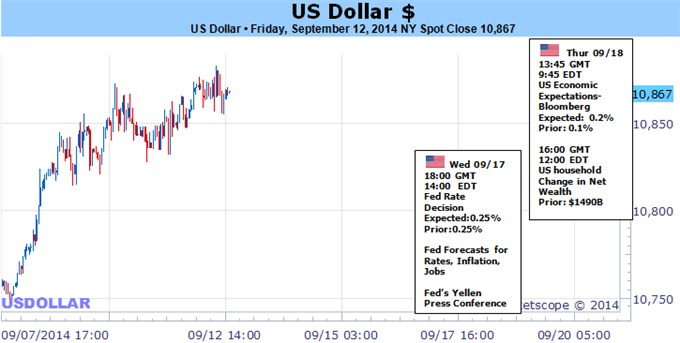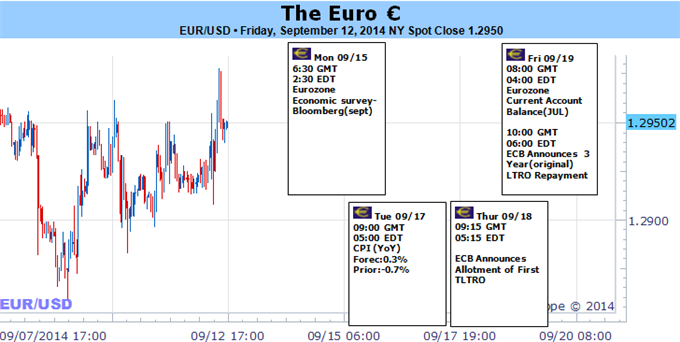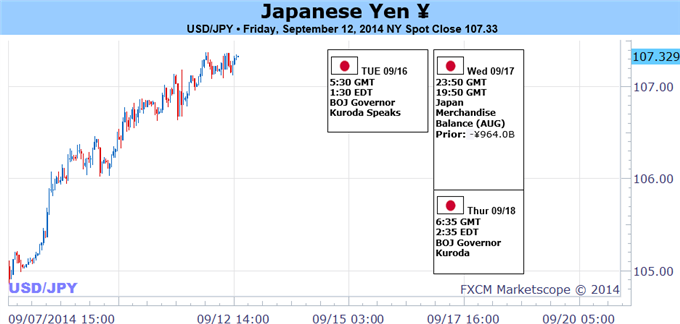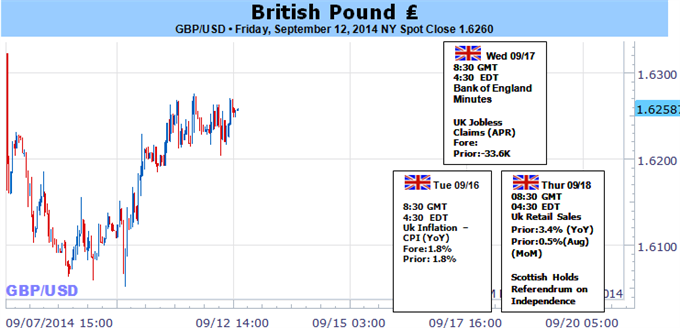Forex Weekly Outlook September 15-19
Inflation data in the UK and the US, German Economic Sentiment, US Federal Funds Rate and FOMC Press conference, GDP in New Zealand, US unemployment claims, Scottish Independence Vote are the major topics in Forex calendar. Check out these events on our weekly outlook.
Last week US jobless claims increased 11,000 last week, reaching 315K, exceeding the revised 304K posted in the week before. However, the 4 week moving average was little affected, rising 750 to 304K, 7% less than a year ago and still behind prerecession levels. Despite sluggish, hiring in August, the general trend is positive. The economy has generated an average of 215,000 jobs a month so far in 2014, up from 194,000 in 2013 and wage growth is expected to rise in the coming months alongside economic expansion. Will this trend continue?
- Haruhiko Kuroda speaks: Tuesday, 5:30. BOE Governor Haruhiko Kuroda will press conference in Osaka. Market volatility is expected.
- UK inflation data: Tuesday, 8:30. Annual inflation rate dropped more than expected in July, reaching 1.6% from 1.9% in June, lowering the chance of an interest rate rise in 2014. Economists expected a smaller decline to 1.8%. The main cause for the sharp fall was price reduction in summer clothing. Inflation was held below the BOE’s 2% target for the seventh consecutive month, indicating the UK economy is stabilizing. However, cost of living and income tax are still too high compared to wage growth. Annual inflation is expected to reach 1.5% in August.
- Eurozone German ZEW Economic Sentiment: Tuesday, 9:00. German economic sentiment plunged in August to 8.6 from 27.1 in July. The 18.5 fall brought sentiment to its lowest level since December 2012. Analysts expected a more modest decline to 18.2 points. The Current Conditions Index dropped to 44.3 from 61.8 in July, missing predictions for a decline to 55.5. The ongoing geopolitical tensions are the main reason for the sharp decline. Economic climate is expected to decline further to 5.2.
- US PPI: Tuesday, 12:30. U.S. producer prices inched marginally in July rising 0.1%, in line with market forecast, following a 0.4% gain in the previous month. The slow advance resulted from a decline in the cost of energy goods, lowering prices of finished goods. Despite the volatility in the PPI series, a trend of inflation is gathering pace, easing the Central Bank’s concerns. The government introduced three new indexes to the PPI series focusing on personal consumption. Personal consumption less food and energy rose 0.2% in July after a 0.3% gain in June. Excluding food, energy and trade services, the index increased 0.2% after a similar rise in June. Producer prices are predicted to gain 0.1% in August.
- UK employment data: Wednesday, 8:30. The number of people claiming unemployment benefits in the U.K. contracted more-than-expected in July, declining a seasonally adjusted 33,600, after a 39,500 fall in the previous month, lowering the Unemployment level to 6.4% in the three months to June. Economists expected a smaller decline of 29,700. Meanwhile, the average earnings index fell 0.2% in the three months to June after a 0.4% gain in the three months to May. The number of job seekers is expected to decline by 29,700 in August.
- US inflation data: Wednesday, 12:30. U.S. consumer prices inched 0.1% in July, in line with market forecast, following a 0.3% rise in June. On a yearly base, consumer prices gained 2.0%, compared to June’s increase of 2.1%. Excluding the volatile food and energy costs, July core consumer prices gained 0.1% after posting the same gain in June. On an annual basis, core CPI rose 1.9%, unchanged from June. Economists expect core CPI to rise above the 2% target next year, prompting the Fed to raise rates in March. U.S. consumer prices is expected to grow by 0.1% whiel Core CPI is predicted to gain 0.2%.
- FOMC Economic Projections, Rate statement and Press conference: Wednesday, 18:00. The Federal Reserve downgraded its outlook for the U.S. economy in its June meeting but continued with tapering as planned. Growth forecast was reduced to 2.1% from 2.3% due to the harsh winter in which the economy contracted 0.1%. However, Fed Chair Janet Yellen stated economic activity has rebounded in the second quarter. The Fed voted unanimously to continue the cut the monthly purchases down to $35 billion. The labor market continues to improve together with underlying strength in the broader economy. Economists believe inflation will rise once the Unemployment rate reaches 6%. Regarding interest rate increase, the Fed may stall its planned hike until reaching solid growth.
- New Zealand GDP: Wednesday, 22:45. New Zealand economy expanded 1.0% in the first quarter following a revised 1.0% in the last quarter of 2013. Construction sector was the main contributor to expansion, rising 12.5%, the largest since March 2000. Retail trade edged up 1.4% and 4.4% on a yearly base. Mining rose 6.3% in the first quarter. Household spending remained unchanged, despite the 7.3% gain in real gross national disposable income, the largest ever annual rise. Exports increased 3.1% for the quarter driven by an 18.6% rise in agriculture and fishing products.
- Switzerland rate decision: Thursday, 7:30. The Swiss National Bank (SNB) decided to maintain its Libor target at the historically-low range of 0% to 0.25%, in line with market forecast. The Central bank stated that economic growth picked up in the first quarter, after a softer fourth quarter last year. However, the Bank also noted that production capacities are still not fully utilized and expects a pickup in economic activity during the coming quarters. The downside risks remained unchanged including weaker-than-expected growth in major economies, geopolitical tensions, Eurozone financial difficulties. No change in rates is expected.
- US Building Permits: Thursday, 12:30. US building permits surged 15.7% in July, reaching a seasonally adjusted annual pace of 1.09-million units. The rise came after two consecutive declines. Economists expected starts to rise to a 969,000-unit rate. The housing market softened after the rise in interest rates. The government reported last month that the homeownership rate hit a 19-year low in the second quarter, while the rental vacancy rate was the lowest in more than 19 years. The number of Building permits is expected to reach 1.04 million units this time.
- US Unemployment Claims: Thursday, 12:30. The number of Americans seeking U.S. unemployment benefits increased by 11,000 last week to 315,000. However, the four-week average inched up only 750 to 304,000. The average remained 7.1% lower than last year. Unemployment benefits data can be volatile around holidays and could explain the 11,000 rise. Overall, the Us labor market continues to strengthen with a clear growth trend. Jobless claims are expected to grow by 312,000 this week.
- Janet Yellen speaks: Thursday, 12:45. Federal Reserve Chair Janet Yellen will speak in Washington DC. She may talk about the US labor market and the prospects of a rate hike following the taper period. Market volatility is expected.
- US Philly Fed Manufacturing Index: Thursday, 14:00. Business conditions in the Philadelphia area improved in August surging to 28 from 23.9 in July. This was the third consecutive rise and posting the highest reading since March 2011. Economists expected a more modest rise to 19.7 points. However despite the less encouraging new orders index, the general tone is positive. Business conditions in the Philadelphia area are expected to decline to 22.8.
- Scottish Independence Vote: Thursday. In September 18, Scottish voters will decide whether to split from the United Kingdom or stay as one country with England, Wales and Northern Ireland. A YouGov poll conducted for The Sunday Times and released on Sunday showed the “yes” vote at 51% and “no” at 49%. Scotland’s first minister and SNP leader Alex Salmond has been a vocal proponent of independence. British Prime Minister David Cameron wants Scotland to remain part of an undivided United Kingdom of Great Britain and Northern Ireland. Uncertainty over the outcome of the Scottish referendum weakened the pound.


 LinkBack URL
LinkBack URL About LinkBacks
About LinkBacks










 Reply With Quote
Reply With Quote







Bookmarks